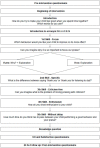AI-based chatbot micro-intervention for parents: Meaningful engagement, learning, and efficacy
- PMID: 36741110
- PMCID: PMC9895389
- DOI: 10.3389/fpsyt.2023.1080770
AI-based chatbot micro-intervention for parents: Meaningful engagement, learning, and efficacy
Abstract
Introduction: Mental health issues have been on the rise among children and adolescents, and digital parenting programs have shown promising outcomes. However, there is limited research on the potential efficacy of utilizing chatbots to promote parental skills. This study aimed to understand whether parents learn from a parenting chatbot micro intervention, to assess the overall efficacy of the intervention, and to explore the user characteristics of the participants, including parental busyness, assumptions about parenting, and qualitative engagement with the chatbot.
Methods: A sample of 170 parents with at least one child between 2-11 years old were recruited. A randomized control trial was conducted. Participants in the experimental group accessed a 15-min intervention that taught how to utilize positive attention and praise to promote positive behaviors in their children, while the control group remained on a waiting list.
Results: Results showed that participants engaged with a brief AI-based chatbot intervention and were able to learn effective praising skills. Although scores moved in the expected direction, there were no significant differences by condition in the praising knowledge reported by parents, perceived changes in disruptive behaviors, or parenting self-efficacy, from pre-intervention to 24-hour follow-up.
Discussion: The results provided insight to understand how parents engaged with the chatbot and suggests that, in general, brief, self-guided, digital interventions can promote learning in parents. It is possible that a higher dose of intervention may be needed to obtain a therapeutic change in parents. Further research implications on chatbots for parenting skills are discussed.
Keywords: AI; artificial intelligence; chatbot; efficacy; intervention; learning; parenting.
Copyright © 2023 Entenberg, Mizrahi, Walker, Aghakhani, Mostovoy, Carre, Marshall, Dosovitsky, Benfica, Rousseau, Lin and Bunge.
Conflict of interest statement
The authors declare that the research was conducted in the absence of any commercial or financial relationships that could be construed as a potential conflict of interest.
Figures
References
-
- Olfson M, Blanco C, Wang S, Laje G, Correll C. National trends in the mental health care of children, adolescents, and adults by office-based physicians. JAMA Psychiatry. (2014) 71:81–90. - PubMed
-
- Kauten R, Barry C. Externalizing behavior. In: Zeigler-Hill V, Shackelford TK. editors. Encyclopedia of Personality and Individual Differences. 1st ed. (Cham: Springer; ) (2020). p. 1509–12. 10.1007/978-3-319-24612-3 - DOI
LinkOut - more resources
Full Text Sources





